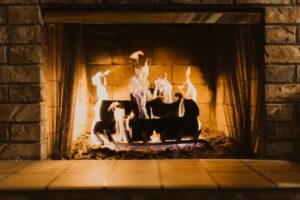 A fireplace is often considered one of the most enchanting features of a home, capable of creating a cozy and inviting atmosphere on cold evenings. However, it is essential to prioritize the proper maintenance of your fireplace to ensure the safety of your household and visitors.
A fireplace is often considered one of the most enchanting features of a home, capable of creating a cozy and inviting atmosphere on cold evenings. However, it is essential to prioritize the proper maintenance of your fireplace to ensure the safety of your household and visitors.
Fireplace Safety and Maintenance Guidelines
Wood Burning Fireplaces:
Check the flue for obstructions: Before lighting a fire, inspect your chimney to ensure it is clear and free from any blockages. Sometimes, birds or other animals may take shelter in the chimney during the off-season, so it’s crucial to check if you haven’t used your fireplace for an extended period.
Keep glass doors open: If you have a traditional wood burning fireplace with glass doors, it is recommended to keep the doors open while using the fireplace. The doors are designed to insulate the room when the fireplace is not in use, rather than containing the fire. By keeping the doors open, you allow proper airflow for the fire while using a screen to prevent sparks and debris from causing damage.
Install a chimney cap: Chimney caps serve multiple purposes, such as protecting the chimney from rain and preventing birds and other creatures from entering. Additionally, installing a screen across the chimney helps prevent sparks from flying out, reducing the risk of fires on roofs or lawns.
Schedule a chimney sweep inspection: If you have burned 70-100 fires, it is advisable to contact a chimney sweep. They will clean any buildup in the chimney and conduct a visual inspection to ensure the chimney is structurally sound and free from potential hazards.
Gas Burning Fireplaces:
Install an oxygen-depletion sensor (safety pilot): Consider installing an oxygen-depletion sensor that acts as a safety mechanism. It can detect any malfunctions in the fireplace or excessive carbon monoxide levels, automatically shutting off the gas supply.
Place carbon monoxide detectors: Install carbon monoxide detectors near the fireplace and on every floor of your home. Ideally, position a couple of detectors per floor to provide comprehensive coverage.
Maintain a safe distance: Keep flammable objects, such as curtains and fabrics, at least three feet away from the outer edge of the fireplace. This precautionary measure minimizes the risk of fires or smoke damage.
Respond to gas odor promptly: If you detect a gas odor in your home, contact your gas company or call 911 immediately. Gas leaks can pose serious safety hazards and should be addressed promptly.
Keep the fireplace damper open: To prevent carbon monoxide from entering your home, ensure that the fireplace damper remains clamped open while the fireplace is in use.
Regardless of the type of fireplace, it is crucial to keep children and pets at a safe distance. Burning fireplaces consume oxygen and produce carbon monoxide, so maintaining functional carbon monoxide alarms is essential to ensure the safety of your family.
Regularly maintaining your fireplaces is just one critical step toward ensuring the safety of your home and guests. It also serves as an effective means of avoiding costly homeowner’s insurance claims and the emotional distress associated with fire-related incidents. By implementing these fireplace safety measures, you can enjoy the warmth and ambiance of your fireplace while keeping your loved ones protected.
